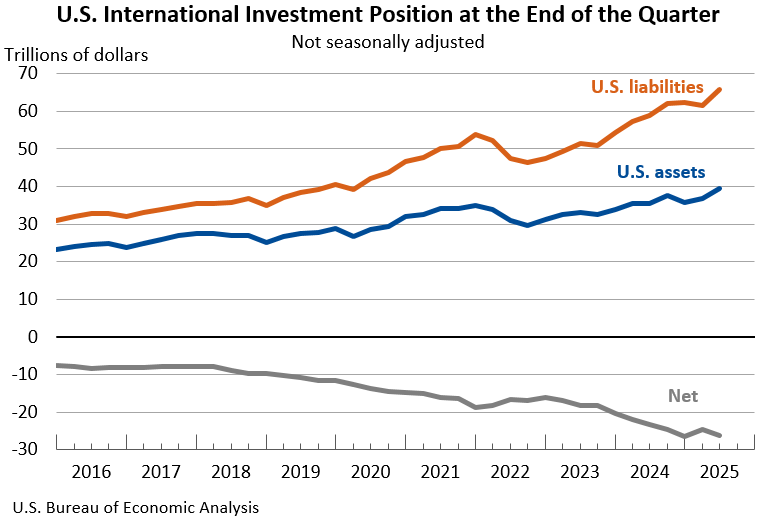Notice
Due to a lapse in appropriations, this website is not being updated.
Bureau of Economic Analysis
U.S. International Investment Position, 2nd Quarter 2025
The U.S. net international investment position, the difference between U.S. residents’ foreign financial assets and liabilities, was -$26.14 trillion at the end of the second quarter of 2025, according to statistics released today by the U.S. Bureau of Economic Analysis. Assets totaled $39.56 trillion, and liabilities were $65.71 trillion. At the end of the first quarter, the net investment position was -$24.65 trillion (revised).
Principal Federal Economic Indicators
Noteworthy
The Latest
Quarterly GDP by Industry Data Improves Understanding of the Economy
In 2009, annual gross domestic product (GDP) for durable goods manufacturing showed a double-digit decline. The industry was the leading annual contributor to the bottoming out of the U.S. economy for that year. But looking at the results through a new experimental quarterly data series reveals a more nuanced and complete picture of what was happening in durable goods manufacturing. It shows that the decline in 2009 largely…
If You Respond to BEA's International Surveys, Please Read This!
New changes in the method of informing businesses about requirements for submitting Bureau of Economic Analysis (BEA) surveys will increase the efficiency of the process and reduce paperwork for both survey respondents and BEA. The new procedures involve the collection of data through BEA’s surveys of direct investment and international trade in services.
May Trade Gap is $48.7 Billion
The U.S. monthly international trade deficit decreased in May, according to the U.S. Bureau of Economic Analysis and the U.S. Census Bureau. The deficit decreased from $50.6 billion (revised) in April to $48.7 billion in May, as imports decreased and exports increased. The previously published April deficit was $50.1 billion. The goods deficit decreased $1.6 billion from April to $63.5 billion in May, and the services surplus increased $0.3…
What is the U.S. Current Account?
The U.S. current account is the broadest measure of trade and income flows between the United States and the rest of the world. Together with the capital and financial account, it is a component of the international transactions accounts compiled by the Bureau of Economic Analysis.
Real Disposable Personal Income Picks Up
Personal income increased 0.2 percent in May, the same increase as in April. The increase in wages and salaries was less than 0.1 percent in May, compared with an increase of 0.1 percent in April.
Current-dollar disposable personal income (DPI)—after-tax income—increased 0.2 percent in May, the same increase as in April.
Real DPI— income adjusted for taxes and inflation—increased 0.3 percent in May after increasing 0.1 percent…
Personal Income and Outlays, May 2012
Personal income increased $25.4 billion, or 0.2 percent, and disposable personal income (DPI) increased $18.5 billion, or 0.2 percent, in May, according to the Bureau of Economic Analysis. Personal consumption expenditures (PCE) decreased $4.7 billion, or less than 0.1 percent. In April, personal income increased $29.4 billion, or 0.2 percent, DPI increased $19.5 billion, or 0.2 percent, and PCE increased $16.2 billion, or 0.1 percent, based…
GDP Growth Slows in First Quarter
Real gross domestic product (GDP) rose 1.9 percent in the first quarter of 2012 after rising 3.0 percent in the fourth quarter, according to estimates released by the Bureau of Economic Analysis. The first-quarter growth rate was unchanged from the second estimate released in May.
Gross Domestic Product, 1st quarter 2012 (third estimate); Corporate Profits, 1st quarter 2012 (revised estimate)
Real gross domestic product -- the output of goods and services produced by labor and property located in the United States -- increased at an annual rate of 1.9 percent in the first quarter of 2012 (that is, from the fourth quarter to the first quarter), according to the "third" estimate released by the Bureau of Economic Analysis. In the fourth quarter, real GDP increased 3.0 percent. The GDP estimate released today is based on more…
Personal Income in States Grows
State personal income growth accelerated to 0.8 percent in the first quarter of 2012, from 0.4 percent in the fourth quarter of 2011. Personal income rose in 47 of the 50 states, fell in Kansas and Mississippi, and was unchanged in Oklahoma. The percent change across states ranged from 2.3 percent in North Dakota to –0.3 percent in Mississippi. Inflation, as measured by the national price index for personal consumption expenditures, increased…




